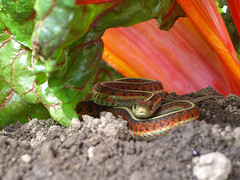This snake sounds like a Texas Garter Snake which is a subspecies of the common garter snake from the United States. It is most commonly found in eastern and central Texas, with a smaller population in Kansas. They are a terrestrial species, generally found in dry, lightly wooded areas.
Garter snakes are completely harmless, and members of the colubrid family and are easily mistaken for other garter snake species. They have a greenish-black back with a distinctive bright orange or red stripe down the center and yellowish stripes on either side of the body.
They are generally not aggressive, and if handled will often flail about wildly to try to escape and release a foul-smelling musk from their cloaca.
Garter snakes have complex systems of phenomenal communication. They can find other snakes by following their pheromone-scented trails. Male and female skin pheromones are so different as to be immediately distinguishable. However, sometimes male garter snakes produce both male and female pheromones. During mating season, this fact fools other males into attempting to mate with these "she-males". This causes the transfer of heat to them in kleptothermy which is an advantage immediately after hibernation so allowing them to be more active. She-males have been shown to garner more copulations than normal males in the mating balls that form at the den when females emerge into the mating melee.
If disturbed, a garter snake may coil and strike, but typically it will hide its head and flail its tail. These snakes will also discharge a malodorous, musky-scented secretion from a gland near the anus. They often use these techniques to escape when ensnared by a predator. They will also slither into the water to escape a predator on land. Hawks, crows, raccoons, crayfish and other snake species such as the coral snake and king snake will eat garter snakes, with even shrews and frogs eating the juveniles.
Being heterothermic, like all reptiles, garter snakes bask in the sun to regulate their body temperature. During hibernation, garter snakes typically occupy large, communal sites called hibernacula. These snakes will migrate large distances to brumate.
Below is a link to a picture of a Texas Garter snake:
Www.google.co.uk/imgres?imgurl=http://www.cnah.org/images/he
Garter snakes are completely harmless, and members of the colubrid family and are easily mistaken for other garter snake species. They have a greenish-black back with a distinctive bright orange or red stripe down the center and yellowish stripes on either side of the body.
They are generally not aggressive, and if handled will often flail about wildly to try to escape and release a foul-smelling musk from their cloaca.
Garter snakes have complex systems of phenomenal communication. They can find other snakes by following their pheromone-scented trails. Male and female skin pheromones are so different as to be immediately distinguishable. However, sometimes male garter snakes produce both male and female pheromones. During mating season, this fact fools other males into attempting to mate with these "she-males". This causes the transfer of heat to them in kleptothermy which is an advantage immediately after hibernation so allowing them to be more active. She-males have been shown to garner more copulations than normal males in the mating balls that form at the den when females emerge into the mating melee.
If disturbed, a garter snake may coil and strike, but typically it will hide its head and flail its tail. These snakes will also discharge a malodorous, musky-scented secretion from a gland near the anus. They often use these techniques to escape when ensnared by a predator. They will also slither into the water to escape a predator on land. Hawks, crows, raccoons, crayfish and other snake species such as the coral snake and king snake will eat garter snakes, with even shrews and frogs eating the juveniles.
Being heterothermic, like all reptiles, garter snakes bask in the sun to regulate their body temperature. During hibernation, garter snakes typically occupy large, communal sites called hibernacula. These snakes will migrate large distances to brumate.
Below is a link to a picture of a Texas Garter snake:
Www.google.co.uk/imgres?imgurl=http://www.cnah.org/images/he

